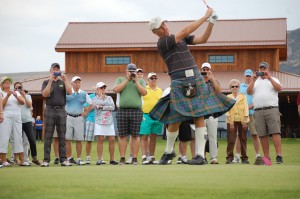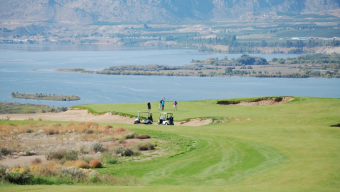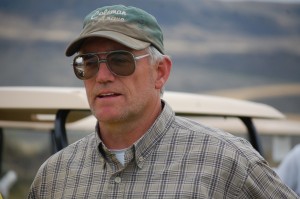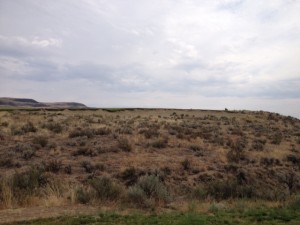BREWSTER, Wa. – It’s been at least a decade-long dream for Cass Gebbers to build a destination golf course in the middle of his vast property in this remote north-central Washington region known more for its apple orchards, sagebrush and tumbleweeds.
It came true this past weekend with the opening of Gamble Sands, a scenic David McLay Kidd-designed layout that ‘floats on the dunes’ above the Columbia River.
So what did Cass Gebbers do when he addressed the gathering media and local dignitaries?
He cried. But not out of joy. He cried out of sadness and despair.
As the patriarch of the century-old Gebbers empire, this should been one of his finest moments, the culmination of so much time, work, planning and dedication. But he couldn’t help himself. All he could think about at that moment were his friends, neighbors and likely family members who had been displaced by the raging wildfires in the area. In the distance over his left shoulder, you could see the smoke from three or four more.
Thousands of families have had to flee their homes. Hundreds of structures have burnt to the foundations. Just that morning Cass had been out to a fire scene and no golf course grand opening could erase the images he witnessed.
That might be all you need to know about Cass and the Gebbers family, which employs more than 100,000 folks in the area for one of the largest apple-producing companies in the nation. He’s got a heart right there on his long-sleeved flannel shirt. Without that compassion, without that respect for the people in his community, there would be no golf course.
This course is essentially a gift from the Gebbers family to the communities of Brewster, Pateros and Okanogan County. Gebbers Farms commands a nice profit from the fruit business. And you don’t make money from golf courses, at least not the initial investors who build and finance a new one.
But what Cass envisioned was a first-class course that would bring golfers from Seattle, Portland, Vancouver and places beyond to play in little-old Brewster, population 2,300. Why else would they come?
And when they came, so would local jobs, so would residual benefits for the area’s restaurants, hotels and other businesses. It wouldn’t be just farms, orchards and cows. Nothing to see there.
“He wanted an upgrade, not just a basic farming area, but to add an asset to their community. It’s been a dream,” said Orrin Vincent, who runs the golf management company that will oversee Gamble Sands. He has been with Cass every step of the way.
“We kind of kept this site in our back pocket. We had started another site earlier,” Gebbers said. “Then 10 years ago I told Orrin, ‘jump in my pickup and we’re going to look at something a little different than you’ve been looking at.’
“So we drove up across this sagebrush and it had cows all over it and he said, ‘holy crap, this looks pretty good.’ ”

Course designer David Kidd, dressed in his fashionable Scottish kilt, had the honor of hitting the first official drive
David Kidd had a similar reaction. He couldn’t believe how accommodating the land was for a golf course. Kidd, renown for designing Bandon Dunes, Tetherow, and The Castle Course at St. Andrews, told Cass he was going to ‘float the course on the dunes” as gently and naturally as possible.
It was built basically on sand, one of the most treasured elements to a course architect. During its construction his team moved just 50,000 cubic yards of material. By contrast, Chambers Bay, which was sitting on an old gravel/sand pit, moved 10 million cubic yards.
It’s a links-style course, in that there are tight fescue lies, large waste areas and a rolling terrain, but based on his years of experience – more precisely mistakes he had made – Kidd added one more element – fun.
“It’s no fun to hunt for golf balls. It’s lots of fun trying to make a birdie,” Kidd said. “How do you avoid that (losing balls), you make wider fairways.
“It’s no fun rolling off the green and watching your ball disappear into a giant bunker. It’s more fun when that ball is sliding away, your heart comes up in your month and you start gripping your fist, and it takes the slope and bounces the right way and not the wrong way. As a golf designer, I can affect that.”
Kidd was in his early 20s when he built Bandon Dunes, rated one of the best courses in the nation. He admits he got a little full of himself and got caught up in “Woods-proofing” courses that would challenge the best golfers around but, as an unintended result, frustrate and alienate regular golfers. Tetherow, in central Oregon, is the best example, a challenging layout that regular folks would need their best day to manage a decent round.
“It’s like a casino, I wanted the odds in my favor. All through the Tiger Woods era, I made sure the odds were heavily stacked in my favor,” Kidd said. “That’s just going to make for a broke casino. No one wants to go to that casino. The odds are far too heavily stacked in its favor. So on this course, we switched it the other way.”
What Kidd has made is a playable, score-able course, with five tee positions ranging from 4,797 yards to 7,169. And did we mention break-taking, with 12 water-view holes above the confluence of the Columbia, Okanogan and Methow rivers.
No. 2 is the hole most golfers will likely remember, not just for its beauty and panoramic view of the rivers and mountains. You’ll remember it as a hole that’s drive-able, par-4, 261 yards (middle tee) downhill. The contours will take even a miss-hit close to the green, if not on. But the green is a jumble of slopes and twists – with bunkers in places you might be likely to land.
“It’s more much difficult to create a challenging golf course that’s very playable,” Kidd said. “When look at No. 2 and you look at the amount of width and you look at the dangers out there and you quickly assess that when make an aggressive stroke you know if you fail, which half the time you do, the danger isn’t a train wreck. You can still rescue a par, maybe a bogey. Double bogey? Very unlikely.”
The No. 3 hole, a par-5, 592-yarder (middle tee) that looks like an enormous challenge for the average golfer on his first tour around the course. The tee is in a valley looking up to a rising plateau. It looks as if you need a 200-plus-yard blind-shot carry over the ridge (really only about 130 to 170 yards) and you have no idea what’s beyond that. Or where the hole is. But if you can avoid the intimidation and just take your normal swing, you can easily carry the ridge.
But then you’ll also find that the further left, the farther you’ll be from the hole. You’ll need to carry the ridge well to the right, which, conveniently, is also the longest carry. It’s a gamble.
What is consistent throughout Gamble Sands is the contours do seem to favor the golfer. If you land in areas on the fairways or surrounding the greens, you generally will receive a member bounce. That’s one of the essentially elements for scoring. And for fun.
“I kind of instinctively knew what to do (at Bandon) and I really didn’t understand it,” Kidd said. “I didn’t fully understand the affect, as a designer, I could have on the rub of the green, how I could influence the bounces. Now 15 years later, I do this, and I really understand my art, I think.
“If can shape a fairway this way or lift a green that way I can really influence what happens. So if you think you got lucky and the ball did something, there a very good chance I did it for you.”
The course was just about ready late last summer (as Golferswest.com wrote about it then. We also did a hole-by-hole look) but the Gebbers wanted to wait until August this year to open so it the grass could be completely grown in, so they could complete the rustic clubhouse and lay down the long road up through the orchards.
This is not the end for the Gebbers. The family, which had started and stopped a Pete Dye-designed course on a bluff above Brewster on more rocky terrain, hopes to build that one when the economy picks up. There are plans for cabins near Gamble Sands and perhaps other courses on other orchards.
“It’s a 15-year plan but it’s hard to see more than 10 years out, really, to develop this whole thing and get the other golf courses going and to develop the property,” Vincent said. “We are only going to do one thing at a time, as it make sense.”
The course derives it name from the Gamble family that originally settled and developed the area and business back in the turn of the 20th Century. Cass Gebbers is part of the fifth generation to run the business and he’s doing things no one would have ever envisioned 100 years – or even 20 years ago.
Even the tag line on their yardage books makes a reference to that history – 1898-2014 – a new beginning.























